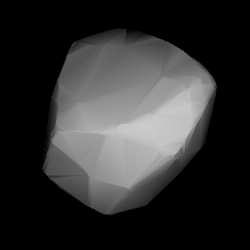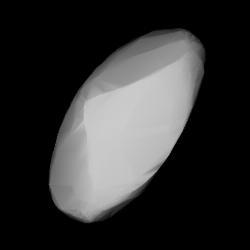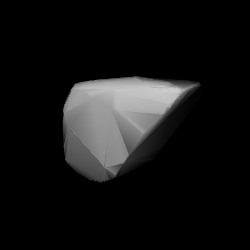2159 Kukkamäki, provisional designation 1941 UX, is a stony asteroid from the inner region of the asteroid belt, approximately 11 kilometers in diameter. It was discovered on 16 October 1941, by Finnish astronomer Liisi Oterma at Turku Observatory in Southwest Finland. It was later named after Finnish geodesist Tauno Kukkamäki.
1049 Gotho, provisional designation 1925 RB, is a carbonaceous asteroid from the outer region of the asteroid belt, approximately 53 kilometers in diameter. It was discovered on 14 September 1925, by German astronomer Karl Reinmuth at Heidelberg Observatory in southwest Germany. Although the name of the asteroid is a masculine German name, it is not known to refer to a particular individual.
1059 Mussorgskia, provisional designation 1925 OA, is a background asteroid from the central regions of the asteroid belt, approximately 25 kilometers in diameter. It was discovered on 19 July 1925, by Soviet astronomer Vladimir Albitsky at the Simeiz Observatory on the Crimean peninsula. The asteroid was named for Russian composer Modest Mussorgsky. The X- or C-type asteroid has a rotation period of 5.636 hours.
1106 Cydonia, provisional designation 1929 CW, is a Eunomian asteroid from the central regions of the asteroid belt, approximately 13 kilometers in diameter. It was discovered on 5 February 1929, by astronomer Karl Reinmuth at the Heidelberg-Königstuhl State Observatory in Germany. The asteroid was named for the fruit-bearing tree Cydonia (quince). The S-type asteroid has a relatively short rotation period of 2.7 hours.
1123 Shapleya, provisional designation 1928 ST, is a stony Florian asteroid from the inner regions of the asteroid belt, approximately 11 kilometers in diameter. It was discovered on 21 September 1928, by Russian astronomer Grigory Neujmin at Simeiz Observatory on the Crimean peninsula. It was named after American astronomer Harlow Shapley.

1457 Ankara, provisional designation 1937 PA, is a stony asteroid from the central region of the asteroid belt, approximately 18 kilometers in diameter. It was discovered on 3 August 1937, by German astronomer Karl Reinmuth at Heidelberg Observatory in southwest Germany, and later named for the Turkish capital city of Ankara.

2839 Annette is a bright Flora asteroid from the inner regions of the asteroid belt. It was discovered on 5 October 1929, by American astronomer Clyde Tombaugh at Lowell Observatory during his search for Pluto. The presumed S-type asteroid has a rotation period of 10.5 hours and measures approximately 5 kilometers in diameter. It was named after the discoverer's daughter.
2033 Basilea, provisional designation 1973 CA, is a stony asteroid from the inner regions of the asteroid belt, approximately 6 kilometers in diameter. It was discovered on 6 February 1973, by astronomer Paul Wild at the Zimmerwald Observatory near Bern, Switzerland. The asteroid was named for the Swiss city of Basel.
2034 Bernoulli, provisional designation 1973 EE, is a stony asteroid from the inner regions of the asteroid belt, approximately 9 kilometers in diameter.
1354 Botha, provisional designation 1935 GK, is an exceptionally dark background asteroid from the outer regions of the asteroid belt, approximately 46 kilometers in diameter. It was discovered on 3 April 1935, by South-African astronomer Cyril Jackson at the Union Observatory in Johannesburg. The asteroid was named after South African prime minister Louis Botha.
1215 Boyer, provisional designation 1932 BA, is a stony Eunomian asteroid from the central region of the asteroid belt, approximately 20 kilometers in diameter. It was discovered by astronomer Alfred Schmitt in 1932, who named it after French astronomer and college Louis Boyer.
1184 Gaea, provisional designation 1926 RE, is an Aerian asteroid from the central regions of the asteroid belt, approximately 20 kilometers in diameter. It was discovered on 5 September 1926, by astronomer Karl Reinmuth at the Heidelberg-Königstuhl State Observatory in southwest Germany. The asteroid was named after the goddess of Earth, Gaea (Gaia), from Greek mythology.
1412 Lagrula, provisional designation 1937 BA, is an asteroid from the inner regions of the asteroid belt, approximately 7 or 23 kilometers in diameter, depending on the body's divergent reflectivity measurements.
1907 Rudneva, provisional designation 1972 RC2, is a stony background asteroid from the central regions of the asteroid belt, approximately 11 kilometers in diameter. It was discovered on 11 September 1972, by astronomer Nikolai Chernykh at the Crimean Astrophysical Observatory, Nauchnyj, on the Crimean peninsula. The asteroid was named after Soviet geodesist and war hero Yevgeniya Rudneva.

1854 Skvortsov (prov. designation: 1968 UE1) is a stony background asteroid and relatively slow rotator from the middle region of the asteroid belt, approximately 9 kilometers in diameter. It was discovered on 22 October 1968, by Russian astronomer Tamara Smirnova at the Crimean Astrophysical Observatory in Nauchnyj on the Crimean peninsula. It is named after astronomer Evgenii Skvortsov.
1807 Slovakia, provisional designation 1971 QA, is a stony asteroid and slow rotator from the inner regions of the asteroid belt, approximately 9 kilometers in diameter. It was discovered on 20 August 1971, by Slovak astronomer Milan Antal at Skalnaté pleso Observatory in the High Tatras mountains of Slovakia and named after the Slovak Republic.
1461 Jean-Jacques, provisional designation 1937 YL, is a metallic asteroid from the outer region of the asteroid belt, approximately 34 kilometers in diameter. It was discovered on 30 December 1937, by French astronomer Marguerite Laugier at Nice Observatory in southern France, who named it after her son Jean-Jacques Laugier.
1530 Rantaseppä, provisional designation 1938 SG, is a stony Florian asteroid from the inner regions of the asteroid belt, approximately 5 kilometers in diameter. Discovered by Yrjö Väisälä at Turku Observatory in 1938, it was later named after Finnish astronomer Hilkka Rantaseppä-Helenius.
1708 Pólit, provisional designation 1929 XA, is a very dark asteroid from the outer region of the asteroid belt, approximately 29 kilometers in diameter. It was discovered on 30 November 1929, by Spanish astronomer of Catalan origin Josep Comas i Solà at the Fabra Observatory in Barcelona, and was later named after Catalan astronomer Isidre Pòlit i Boixareu.

1380 Volodia is a carbonaceous background asteroid from the outer region of the asteroid belt. It was discovered on 16 March 1936, by French astronomer Louis Boyer at the North African Algiers Observatory in Algeria. Five nights later, Volodia was independently discovered by Eugène Delporte at Uccle in Belgium. The dark D-type asteroid has a rotation period of 8 hours and measures approximately 22 kilometers in diameter.




